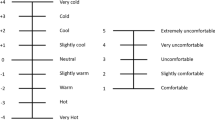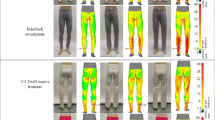Abstract
Regional sweating patterns and body surface temperature differences exist between genders. Traditional sportswear made from one material and/or one fabric structure has a limited ability to provide athletes sufficient local wear comfort. Body mapping sportswear consists of one piece of multiple knit structure fabric or of different fabric pieces that may provide athletes better wear comfort. In this study, the ‘modular’ body mapping sportswear was designed and subsequently assessed on a ‘Newton’ type sweating manikin that operated in both constant temperature mode and thermophysiological model control mode. The performance of the modular body mapping sportswear kit and commercial products were also compared. The results demonstrated that such a modular body mapping sportswear kit can meet multiple wear/thermal comfort requirements in various environmental conditions. All body mapping clothing (BMC) presented limited global thermophysiological benefits for the wearers. Nevertheless, BMC showed evident improvements in adjusting local body heat exchanges and local thermal sensations.







Similar content being viewed by others
References
AATCC (2012) AATCC 195 Liquid moisture management properties of textile fabrics. American Association of Textile Chemists and Colorists. Research Triangle Park, NC
Adidas AG (2012) Available from: http://www.adidas.com. Accessed 1 Mar 2013
Burke R, Curran A, Hepokoski M (2009) Integrating an active physiological and comfort model to the Newton sweating thermal manikin. Proceedings of the 13th International Conference on Environmental Ergonomics (ICEE). University of Wollongong, Wollongong, pp 313–317
Choi JK, Miki K, Sagawa S, Shiraki K (1997) Evaluation of mean skin temperature formulas by infrared thermography. Int J Biometeorol 41:68–75
Clark RP, Mullan BJ, Pugh LG (1977) Skin temperature during running- a study using infra-red colour thermography. J Physiol 591:53–62
Craft Sweden AB (2012) Available from: http://www.craft.se/en. Accessed 1 Mar 2013
Farnworth B (1986) A numerical model of the combined diffusion of heat and water vapor through clothing. Text Res J 56:653–665
Fiala D, Lomas KJ, Stohrer M (1999) A computer model of human thermoregulation for a wide range of environmental conditions: the passive system. J Appl Physiol 87:1957–1972
Foda E, Sirén K (2012) A thermal manikin with human thermoregulatory control implementation and validation. Int J Biometeorol 56:959–971
Fournet D, Redortier B, Havenith G (2012) A method for whole-body skin temperature mapping in humans. Thermol Int 22:157–159
Fournet D, Ross L, Voelcker T, Redortier B, Havenith G (2013) Body mapping of thermoregulatory and perceptual responses of males and females running in the cold. J Therm Biol 38:339–344
Havenith G, Fogarty A, Bartlett R, Smith CJ, Ventenat V (2008) Male and female upper body sweat distribution during running measured with technical absorbents. Eur J Appl Physiol 104:245–255
Havenith G, Holmér I, Parsons K (2002) Personal factors in thermal comfort assessment: clothing properties and metabolic heat production. Energy Buildings 34:581–591
Hunold S, Mietzsch E, Werner J (1992) Thermographic studies on patterns of skin temperature after exercise. Eur J Appl Physiol Occup Physiol 65:550–554
ISO (1993) ISO 11092 textiles-physiological effects-measurement of thermal and water-vapour resistance under stead-state conditions (sweating guarded-hotplate test). International Organization for Standardization, Geneva
ISO (1996) ISO 5084 textiles-determination of thickness of textiles and textile products. International Organization for Standardization, Geneva
ISO (1995) ISO 9237 textiles-determination of the permeability of fabrics to air. International Organization for Standardization, Geneva
Kicklighter TH, Edsall JR, Martin M (2011) Effect of moisture-wicking garments on temperature regulation during exercise. Int J Athl Ther Trai 16:9–13
Kinnicutt P, Domina T, MacGillivray M, Lerch T (2010) Knit-in 3D mapping's effect on thermoregulatory: preliminary results. J Text I 101:120–127
Kitteringham G (2006) Outdoor clothing now matches insulation to specific zones. Tech Text Int 15:21–22
Machado-Moreira CA (2011) The regional distribution of human sudomotor function and its neuropharmacological control. University of Wollongong, Wollongong
McGuffin R, Burke R, Huizenga C, Zhang H, Vlahinos A, Fu G (2002) Human thermal comfort model and manikin. The SAE (Society of Automotive Engineers) Future Car Congress, Arlington, VA, June 2002, SAE Paper Number 2002-01-1955
Ouzzahra Y, Havenith G, Redortier B (2012) Regional distribution of thermal sensitivity to cold at rest and during mild exercise in males. J Therm Biol 37:517–523
Park JH, Yoo SJ (2012) Upper body mapping of sweat rate for development of cycle wear. J Korean Soc Living Environ Syst 19:171–177 (in Korean)
Psikuta A (2009) Development of an ‘artificial human’ for clothing research. De Montfort University, Leicester
Psikuta A, Richards M, Fiala D (2008) Single-sector thermophysiological human simulator. Physiol Meas 29:181–192
Psikuta A, Wang LC, Rossi RM (2013) Prediction of the physiological response of humans wearing protective clothing using a thermophysiological human simulator. J Occup Environ Hyg 10:222–232
Smith CJ, Havenith G (2011) Body mapping of sweating patterns in male athletes in mild exercise-induced hyperthermia. Eur J Appl Physiol 111:1391–1404
Smith CJ, Havenith G (2012) Body mapping of sweating patterns in athletes: a sex comparison. Med Sci Sport Exer 44:2350–2361
Spencer-Smith JL (1978) The physical basis of clothing comfort, Part 6: application of the principles of the design of clothing for special conditions. Cloth Res J 6:61–67
Wang F, Del Ferraro S, Lin LY, Mayor TS, Molinaro V, Ribeiro M, Gao C, Kuklane K, Holmér I (2012a) Localised boundary air layer and clothing evaporative resistances for individual body segments. Ergonomics 55:799–812
Wang F, Psikuta A, Aeberhart M, Wang LC, Weder M, Rossi RM (2012b) Effects of body motion and wind on thermal comfort properties evaluated using a manikin with realistic gait patterns. Proceedings of the 9th International Meeting on Thermal Manikin and Modeling (9I3M). Waseda University, Tokyo, pp 1–5
Wang F, Rossi RM (2013) A novel ‘modular’ body mapping clothing (BMC) kit. US Design Patent, pending
Zhang H, Huizenga C, Arens E, Yu T (2001) Considering individual physiological differences in a human thermal model. J Therm Biol 26:401–408
Acknowledgments
This study was financially supported by a European Union Marie Curie project (project number: 209369) and FW was supported by the Killam Trusts at the University of Alberta.
Conflict of interest
The authors declare that they have no conflict of interest.
Author information
Authors and Affiliations
Corresponding author
Rights and permissions
About this article
Cite this article
Wang, F., Del Ferraro, S., Molinaro, V. et al. Assessment of body mapping sportswear using a manikin operated in constant temperature mode and thermoregulatory model control mode. Int J Biometeorol 58, 1673–1682 (2014). https://doi.org/10.1007/s00484-013-0774-4
Received:
Revised:
Accepted:
Published:
Issue Date:
DOI: https://doi.org/10.1007/s00484-013-0774-4




